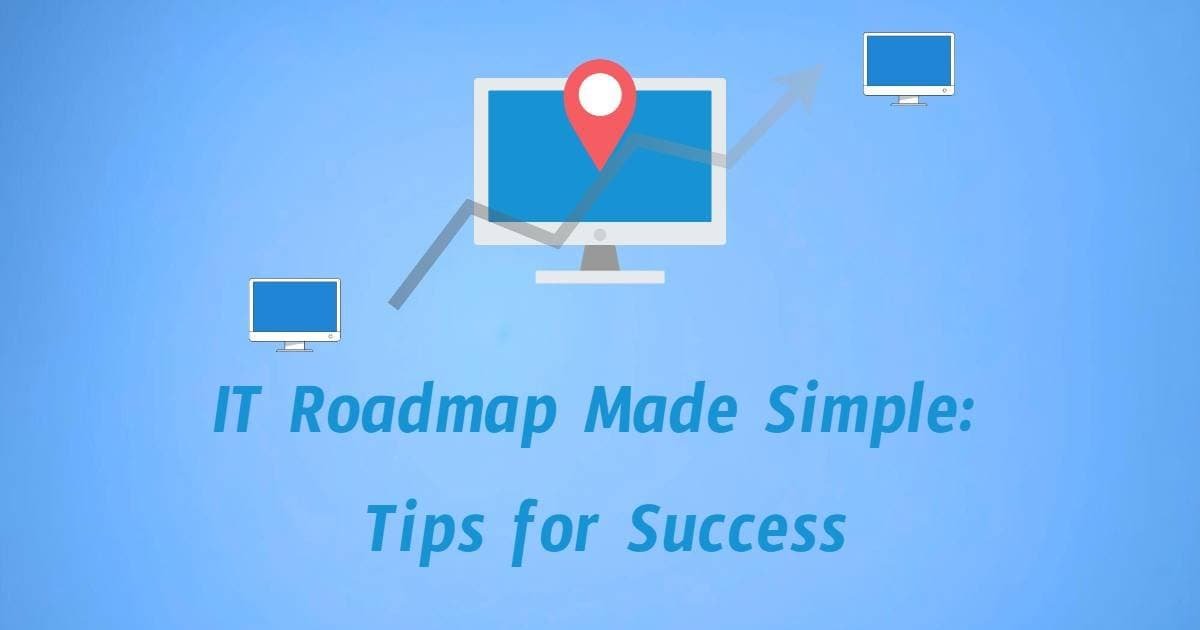IT Roadmap Made Simple: Tips for Success
In today’s fast-paced world, IT and technology play a crucial role in determining the success of any organization. To navigate through the complex IT landscape, organizations need to have one that outlines their IT strategy and goals.
Today, we will explore the concept of IT roadmaps, their importance, key components, different types, and visualization methods,
Whether you are an IT manager or a business leader looking to improve your organization’s IT infrastructure, this blog will provide valuable insights into creating a practical roadmap that aligns with your organization’s goals and objectives.
Understanding the Concept of an IT Roadmap
What is an IT roadmap, you ask? An IT or a technology roadmap provides a visual plan for technology initiatives, ensuring technology solutions align with business goals. The use of templates facilitates strategic planning. This roadmap also guides the development process of new software, considering technological change and risk factors.
Incorporating product management, initiatives, and projects serves as the first step in technology roadmapping. By creating this strategic IT guide, you can effectively navigate the ever-changing landscape of technology.
Defining IT Roadmap
An IT roadmap outlines the initiatives of the IT department that align with business goals. It considers technical debt and architecture roadmap decisions. It communicates the broader strategic objectives of the company and helps create a strategic and impactful guide.
The Evolution of IT Roadmaps
Traditional roadmaps, which once focused primarily on project management and specific dates, have evolved significantly. In modern times, IT and tech roadmaps now consider business strategy and digital transformation. Including product software and visual plan creation has transformed the design process.
Additionally, the influence of agile development processes has played a significant role in shaping their evolution. Today, they address complex projects and enterprise-wide technology implementation, enabling organizations to navigate the ever-changing IT landscape effectively.
Role and Importance of an IT Roadmap
A practical IT roadmap plays a crucial role in strategic planning and decision-making. It helps align technology initiatives with the business objectives of an organization, ensuring that technology projects are in line with broader company goals.
By streamlining business operations and internal systems, it can enhance efficiency and productivity. It acts as a guide for large enterprises and software companies, ensuring that they stay on track and achieve their desired outcomes.
Facilitating Strategic IT Planning
Facilitating strategic IT planning is a vital aspect of a practical technology or an IT roadmap. By enabling strategic decisions and planning of technology initiatives, it helps to identify technology alternatives and solutions aligned with business objectives.
Program managers can prioritize projects and allocate resources based on the roadmap while guiding the development of technology roadmap templates. Strategic planning ensures that technology initiatives align with business goals, fostering a cohesive and efficient approach to IT management.

Streamlining Business Operations
A practical IT or technology roadmap is crucial in streamlining business operations by implementing tech solutions, and any business can use these functions. By identifying technological changes that can optimize business processes, roadmaps help streamline internal systems, procedures, and information technology.
Additionally, they serve as a guide for teams to understand the company’s strategic initiatives and efficiently achieve the organization’s business goals. Utilizing product management principles and incorporating strategic roadmap planning, businesses can take the first step towards streamlining their operations and achieving success.
Critical Components of an Effective IT Roadmap
A practical IT roadmap consists of critical components that ensure the success of technology initiatives.
- Goals and objectives provide direction and purpose
- Well-defined timelines and milestones help manage project progress.
- Resources required, such as team members and technology systems, are carefully considered to support implementation.
- Risk management is an integral part of a practical one that addresses potential risks and mitigating factors.
Ultimately, the roadmap aligns technology implementation with the overarching business strategy, ensuring synergy and success.
Goals and Objectives
Defining the goals and objectives is a crucial aspect. It ensures that tech initiatives are aligned with the overall business objectives. By providing clarity and direction to internal teams and stakeholders, goals and objectives guide the development process of technology solutions.
Moreover, they serve as a means to communicate the business goals effectively to the technology teams. With a strategic guide, organizations can chart a clear path toward achieving their desired outcomes.
Timeline and Milestones
These roadmaps include a carefully planned timeline that outlines the various technology initiatives. These timelines are essential for project management and help teams track progress effectively. Critical stages of project development and implementation are marked by milestones, ensuring that teams stay on track and meet deadlines.
Additionally, they establish realistic project timelines considering dependencies, making them an integral part of successful IT and other tech projects. By incorporating timelines and milestones, organizations can ensure a smooth execution.
Resources Required
To effectively execute IT initiatives, it is crucial to consider the resources required.
- This includes team members with expertise in product management
- The technology systems and software solutions needed.
- Resource planning is vital in ensuring that technology projects have the necessary support.
By allocating resources effectively and considering business operations, teams can plan and budget for their technology initiatives. This allows for seamless execution and successful implementation of updates and keeps track of any additional company technologies required.
Different Types of IT and Technology Roadmaps
IT roadmaps encompass different types, such as enterprise roadmaps and project-specific roadmaps. Enterprise IT roadmaps provide a strategic plan for technology implementation across the entire organization. On the other hand, project-specific roadmaps focus on specific initiatives, outlining goals, timelines, and key stakeholders.
Practical guides align technology initiatives with business goals, ensuring that the chosen solutions support operations. Utilizing templates can aid teams in creating visual plans that effectively communicate strategic decisions.
Enterprise IT Roadmap
A practical strategic IT roadmap is crucial for aligning business strategies and technology initiatives. It serves as a visual plan that outlines the company’s broader goals and technology systems. This guide helps internal teams, product managers, and project managers understand vital initiatives and their timelines.
It enables the development process and implementation of new software, architecture, or technology alternatives. Additionally, the enterprise roadmap considers risk factors, technical debt, and specific dates for project milestones.
Project-Specific IT Roadmap
A project-specific IT roadmap focuses on specific initiatives, such as product development or new software implementation. It visualizes strategic initiatives, key stakeholders, and product software. It guides project management, team members, and software companies, ensuring projects align with business objectives.
It helps plan technology implementation, considering risk factors, technological change, and business strategy. The plan facilitates the creation of other project-specific systems for complex projects involving product managers, program managers, and development teams.
How to Visualize Your IT Roadmap?
To effectively visualize your IT roadmap, it is crucial to choose the right visualization tools. These tools, such as roadmap software, help in planning, tracking, and communicating technology initiatives.
Clear and concise visualization using visual elements, color coding, and concise labels is essential for effective communication and alignment with stakeholders.
Choosing the Right Visualization Tools
When choosing the right visualization tools for your organization’s roadmap, there are several factors to consider. Ease of use, collaboration features, and integration capabilities should be considered to ensure the selected tools align with your specific needs and goals. Commonly used tools include roadmap software, project management software, and visual planning software.
It’s crucial to involve the software architect, IT team, and information technology department in the selection process to ensure that the chosen tools support creation and align with the company’s broader strategic goals.
Tips for Clear and Concise Visualization
To ensure clear and concise visualization, it is essential to use visual elements such as timelines, charts, and graphs. Color coding typically differentiates between different projects, initiatives, or critical milestones. Labels and descriptions should be kept concise, using key terms and familiar language for stakeholders.
Regularly updating and maintaining the visual plan is crucial to reflect the latest information and strategic decisions. Seeking feedback from stakeholders, product managers, and internal teams can help improve optical clarity.
How is an IT Roadmap different from an IT Strategic Plan?
An IT roadmap and an IT strategic plan serve different purposes. While the strategic plan sets the overall vision and goals for technology implementation, the roadmap focuses on specific initiatives, outlining goals, timelines, and stakeholders.
They support the strategic plan by visualizing how technology solutions align with business objectives. The graphic below from the Nielson Norman Group shows how these plans can end up in different places based on the questions asked.

Source: NNgroup
The Process of Developing an IT Roadmap
To develop a practical IT roadmap, it is essential to align strategic planning with business goals and objectives. Collaboration with key stakeholders is crucial to gather input and insights. The assessment of current technology systems helps identify areas of improvement.
Creating a visual plan that outlines the technology roadmap is a vital step. Prioritizing initiatives based on business strategy and technological change ensures you develop an appropriate strategic guide.
Preliminary Phase
In the preliminary phase, a thorough assessment of the organization’s current technology systems is conducted.
- Business objectives and goals are identified and prioritized, with input and insights gathered from internal teams and stakeholders.
- Technology alternatives and solutions are carefully evaluated, considering factors such as product management and new product initiatives.
- Finally, specific dates and milestones are defined for implementation.
- This first step in technology roadmapping sets the foundation for successful development and execution.
Development Phase
During the development phase, it is crucial to create a strategic plan that aligns with the broader goals of the company.
- Consideration of risk factors and potential roadblocks is essential to ensure smooth progress.
- Engaging key stakeholders, such as product managers and IT team members, throughout the development process helps gather valuable insights and input.
- Feedback should be incorporated, and necessary adjustments should be made to the roadmap.
- Continuous monitoring and updates are required as technology and business objectives evolve.
How can an IT Roadmap Benefit Your Organization?
A practical IT roadmap can benefit your organization in several ways. It helps identify cost-saving projects and process efficiencies, provides a visual plan for stakeholders to understand and support technology initiatives, aligns technology projects with business strategy, enhances project management by outlining key milestones and timelines, and improves communication and coordination among internal teams and stakeholders.
Cost Savings
Identifying technology initiatives that can lead to cost savings, such as process automation, is a crucial step. Prioritizing projects based on their potential return on investment ensures that resources are allocated efficiently.
Evaluating technology alternatives that streamline operations and reduce expenses is another crucial consideration. Opportunities to consolidate systems and eliminate redundant technology solutions should be identified.
Continuously monitoring project costs throughout the IT guide implementation ensures alignment and maximizes cost savings.
Better Strategic Alignment
Aligning technology initiatives with business goals and objectives is crucial for better strategic alignment. It is essential to identify projects that can support broader strategic initiatives, ensuring that technology solutions align with the company’s strategic decisions.
Continuous evaluation of the roadmap is necessary to ensure it remains aligned with business objectives. Additionally, communicating the strategic value of technology projects across the organization facilitates better strategic alignment.

Are IT Roadmaps and Project Management Interdependent?
IT roadmaps and project management go hand in hand, with roadmaps providing a strategic plan for project managers to follow. Project management ensures the successful implementation of initiatives, providing a broader context for projects. Together, they ensure the timely and budget-conscious completion of industries as well.
Why is Stakeholder Engagement Crucial in IT Roadmapping?
Stakeholder engagement plays a crucial role in IT roadmapping. It ensures the roadmap aligns with the organization’s needs and fosters buy-in and support for technology initiatives.
They provide valuable insights during roadmap development, promoting collaboration and alignment across teams. Continuous engagement helps monitor and update the guide continually.
What are the Challenges in Creating an IT Roadmap?
Balancing short-term needs with long-term strategic objectives, managing competing priorities and limited resources, adapting to technological change and new software solutions, addressing technical debt and legacy systems, and ensuring alignment between the roadmap and business operations are some challenges in creating a practical IT roadmap.
Conclusion
Developing a practical IT roadmap is crucial for the success and growth of your organization. It helps you align technology initiatives with your business goals, streamline operations, and ensure efficient resource allocation.
By setting clear goals, defining timelines, and visualizing your process, you can effectively communicate your IT strategy to stakeholders and team members.
However, creating one can be challenging. It requires careful planning, stakeholder engagement, and overcoming obstacles. To gain a better understanding of how they are implemented in various industries, check out some roadmap examples.
If you’re interested in exploring other IT-related topics, check out our related articles for more valuable insights and information.
